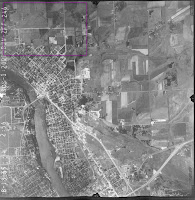You know how a mystery can sit in the back of your mind for years, and then one foggy weekend 46 years later, answers appear just like that?
When we were kids, we had a wide area to roam, as long as we were home by supper. We'd go "exploring" in the woods that were across the field behind our house (upper right, second 1965 aerial map below). (BTW, someone drew-in the horizontal road in the pic. It was not there). We'd go a little farther each time out, and one day, I remember realizing we were following an abandoned railroad (!). It was a built-up bed, with ties overgrown with moss and grass, and the trees on either side made an arch overhead. It was a green heaven to me, and I felt like Thor Heyerdahl at least. See the diagonal sort of space going NE? Could that have been it?
"Probably NOBODY ELSE KNOWS about this!", I thought.
 Even better, the railroad ended at an abandoned quarry. I was sure we'd stumbled on a secret...fort... or bunker...or something (What's a bunker? None of us knew, but it sounded pretty cool ☺).
Even better, the railroad ended at an abandoned quarry. I was sure we'd stumbled on a secret...fort... or bunker...or something (What's a bunker? None of us knew, but it sounded pretty cool ☺).
Since this was a SECRET discovery, it was probably 2 weeks before I mentioned it to someone who might know: the old man who owned the coal company downtown. (That was where we got chunks of bituminous to make **salt gardens). He thought it might have been abandoned "during the Civil War". Ever gullible, I believed him for years.
Eventually, we studied WWII and the "war effort"-- could the rails have been torn up then? But what would account for all the youngish trees up there? Even I knew what a hundred-year-old tree looked like, but the romantic me thought the Civil War sounded fine, ya know?
(Oooo! Added months later, from the 1938 St Cloud promo booklet the WPA paid for:)
Cool, huh?
---------------
---------------
 Then last night, Larry found these photos of the Sauk Rapids Granite Company, and the locomotive that was used on their own railroad to and from the quarries EAST of town.
Then last night, Larry found these photos of the Sauk Rapids Granite Company, and the locomotive that was used on their own railroad to and from the quarries EAST of town.WOW.
A lifetime mystery, solved. The only question still outstanding is, where did the tracks run?
Sauk Rapids is built in the valley (and up the hillside) formed by the Mississippi. The quarry was probably 3 miles up over the hill from the river, but the train must have taken a more gradual route. The granite shed was still there when we were kids, about where the new bridge lands on the SR side of the river. (OR, see the first map up there? The granite co was north of the bridge about 4 blocks, between Broadway and the Northern Pacific tracks).
And look ◄...whenever the granite industry was active in SR, there were no trees to get in the way of commerce.
Oh, and "they" knew about the abandoned quarry. It eventually became the "scenic" town dump.

Whew! Cool, huh?
+:+:+:+:+:+:+:+:+:+
Added May, 2016: Another WOW is this map of Sauk Rapids from 1903-- THERE'S the Granite Co Railroad!
Evidently, they just backed down the tracks with a load of granite, then forward to the sheds (about where the S in Sauk Rapids is if I recall correctly). Isn't this COOL?
(Oh, and look how Rogosheski was spelled originally ☺)
+:+:+:+:+:+:+:+:+:+:+
**To make a salt rock garden In a glass or plastic bowl, put some pieces of coal, coke, porous brick, tile, cement or sponge.
Day 1: Over the base material, pour two tablespoons of water, two of table salt (iodized or plain)
and two of Mrs. Stewart’s Bluing.
Day 2: Add two more tablespoons of salt.
Day 3: Pour into the bottom of the bowl (not directly on the base material) two tablespoons each of
salt, water, and Mrs. Stewart’s Bluing, and then add a few drops of mercurochrome, vegetable
coloring or ink to each piece.
By this time a beautiful flower-like growth should have appeared. If all the conditions are not
ideal, it may be necessary to add two tablespoons of household ammonia to aid the growth. A free
circulation of air is necessary, and these formations will develop better where the air is dry.
To keep it growing: Add more M.S.B., salt and water from time to time. It will “bloom”
indefinitely into beautiful rosebuds, coral and crystal. Try it!











I can't believe you didn't talk about the dead guy in the quarry! I avoided all quarries for years in case it might happen again. Do you remember it? He was found just about this time of year in the ice. I don't think I saw it, but it is so vivid in my mind, I thought I had seen it for a bit. Where, by the way, was the railroad line you found as a kid? Like where from the end of the woods? love, Pfoofer
ReplyDelete